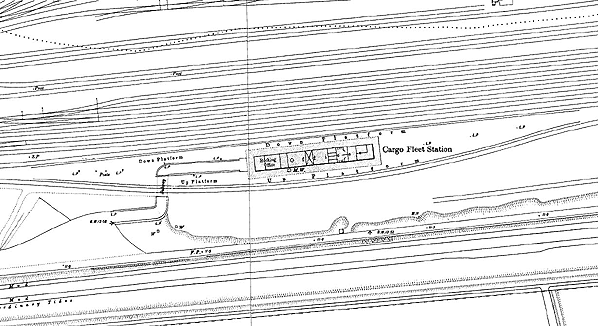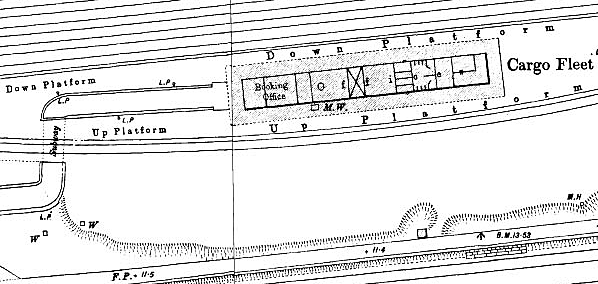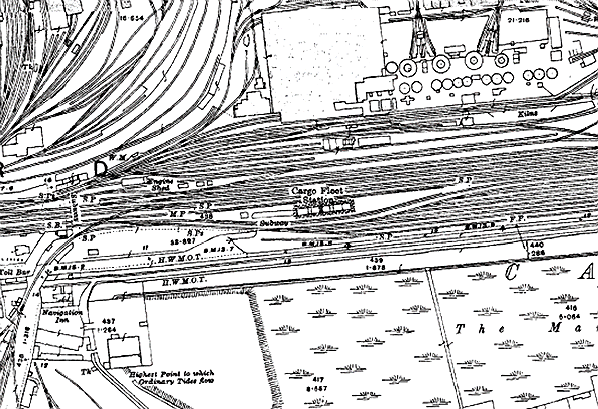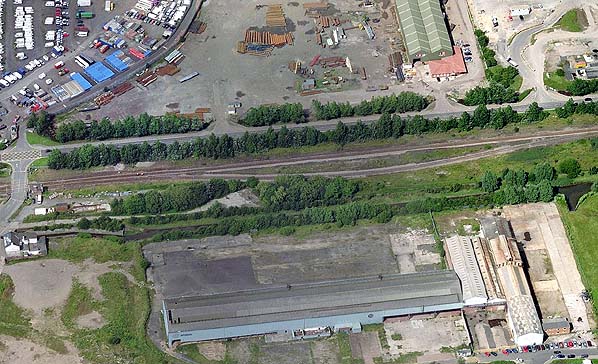Notes: MIDDLESBROUGH AND THE SOUTH BANK OF THE RIVER TEES
Cargo Fleet station was situated a little over a mile east of Middlesbrough on the railway to Redcar and Saltburn. Although now a large town of over 140,000 inhabitants, Middlesbrough was a late arrival on the urban map of Britain. For centuries Stockton was the lowest bridging point and principal port close to the mouth of the River Tees. In 1811 Middlesbrough was little more than a hamlet, with 35 inhabitants, and by 1831 the figure was still only 154. The foundation of the town was prompted by the opening of the Stockton & Darlington Railway (SDR) in 1825, the pioneering passenger and mineral line whose primary function was to carry coal from central and western County Durham to tidal water for export. At first Stockton was expected to suffice as the coal port, but it was soon evident that larger facilities closer to the sea were needed. Joseph Pease, a prominent figure in the Stockton & Darlington Railway and a member of the influential Quaker banking family, sailed up the Tees in 1828 seeking a site for new coal staiths. He persuaded the management of the S&D to extend the railway eastwards from Stockton, and by 1830 it reached the new staiths close to Middlesbrough Farm (almost directly north of the present Middlesbrough station). There was some debate about what to call this new port, which was at first known as Port Darlington; other options were Linthorpe, Leventhorpe, Acklam and Middlesbrough. A group of speculators, including Pease, set up the Owners of Middlesbrough Estate, and purchased 527 acres for the construction of a new town to service the port, on a site described by a contemporary reporter as ‘a dismal swamp’.
 |
From the 1840s ironworks were established close to Middlesbrough, and the discovery of good quality ironstone in the Cleveland Hills near Eston several miles south-east of the town, prompted the rapid expansion of the industry along the southern bank of the Tees; a branch line from the Eston mines contributed traffic to the line through Cargo Fleet. In |
1862 the Chancellor (later Prime Minister) Gladstone recognised Middlesbrough’s huge potential when he described the growing town as an ‘Infant Hercules’. By the 1880s there was an ironmasters’ district with a complex of furnaces, rolling mills, sheet mills, foundries, wire mills, coke ovens and concrete works served by an extensive and intricate network of railways. When steel supplemented iron production the local Cleveland ore was found unsuitable, so ore was imported from abroad, and this required additional docks and sidings. Cargo Fleet was in the midst of this industrial zone.
By the 1920s several miles of the south bank of the Tees adjoining the Middlesbrough to Redcar line, on which Cargo Fleet station was situated, were lined with industry. Since WWI iron and steel had been joined by chemicals, originally at Billingham on the Durham (north) bank, but in the following decades oil refining and petrochemicals were added to the mix, and the Wilton plant, producing synthetic textiles, sprawled across an extensive site south of the railway several miles east of Cargo Fleet. This busy industrial region continued to grow in the 1960s as tidal mud banks of the Tees estuary were reclaimed for new factories and docks, and the author’s recollection of his first train journey between Middlesbrough and Redcar in 1963 was of a tormented landscape swathed in smoke and steam, a nauseous smell of sulphur, and huge expanses of sidings where steam locos were hauling and shunting rakes of wagons. Whilst de-industrialisation set in elsewhere by the 1970s, Teesside’s heavy industries battled on, and their thirst for water was a principal reason for damming the North Tyne, seventy miles away, to create Kielder Water reservoir (which inundated part of the former Border Counties Railway at Plashetts). In 1979 Britain’s last integrated steel mill - including Europe’s largest blast furnace - opened at the mouth of the Tees near Redcar. This necessitated the diversion of a stretch of the Middlesbrough – Redcar Railway and the construction of yet another complex of sidings. However, even as the new steel mill was under construction, Teesside was following the rest of the heavy industrial regions into rapid decline, and in the 1980s-90s many of the factories were abandoned. The scenes of dereliction along the railway route were as ugly as they were distressing. From the early 1990s, as work progressed to transform the Tees estuary from its grossly polluted state, reclamation was carried out of the derelict industrial land; a few hundred yards west of Cargo Fleet station a ‘flagship’ development on a brownfield site is the Riverside Stadium, home of Middlesbrough FC, which opened in 1995.
 |
BRIEF HISTORY OF THE MIDDLESBROUGH & REDCAR RAILWAY
The Middlesbrough & Redcar Railway, authorised by an Act of 21 July 1845, opened to passengers on 5 June 1846, but from the outset the line was an important goods route. The first train was hauled by Locomotion No 1. The original Middlesbrough station was replaced with a new facility the following year, and the present station opened in December 1877. The line was leased to the SDR on 1 October 1847 and formally amalgamated with this company on 30 June 1862. In turn, the North Eastern Railway (NER) absorbed the SDR on 13 July 1863. At the eastern end, the original terminus at Redcar was replaced on 19 Aug 1861when the line was extended to Saltburn. In the late nineteenth century Redcar, Marske and Saltburn developed as holiday resorts, serving as playgrounds for the burgeoning population of Middlesbrough and its conurbation, but they also aspired to attract visitors from further afield.
 |
The route of the Middlesbrough & Redcar Railway was on the flat land south of the Tees, within a mile of the river bank, the steepest stretch of the line being a rise at 1in 242 on the approach to Redcar. Stations on this line present a challenge to railway historians, as some of their dates of opening are difficult to establish, some were probably or definitely re-sited, and names were changed and even exchanged between stations.
In 1861 a mineral line opened from Normanby Jetty on the Tees, a short distance north-east of Cargo Fleet to Normanby mines and beyond, with a link built from the Middlesbrough – Redcar line in 1865. On 1 January 1902 a passenger service was introduced on this line from Middlesbrough, through Cargo Fleet station, to a new terminus at Eston; this branch was remarkable in having no intermediate stations in the three miles between Cargo Fleet Junction and Eston. The passenger service to Eston lasted only until 11 March 1929, a casualty of motor bus competition.
EARLY STATIONS AT CARGO FLEET
Cargo Fleet is one of the more interesting station names in north-east England. Its apparent reference to maritime goods shipments is misleading as it is believed to mean ‘cold stream’ (another NER station name!). A station was open by April 1847, as instructions have been found to provide a nameboard for ‘Cleveland Port’ station, and in March 1848 a platform was ordered for ‘Cargo Fleet’ – referring to the same location. The station appeared as Cleveland Port in the railway company timetables by September 1847, as it did in Bradshaw until 1867, whilst company minutes generally referred to it as Cargo Fleet. Company minutes of 1851 and 1865 also reveal that the station (Cargo Fleet or Cleveland Port) might have been re-sited either once or twice. In the light of this it is difficult to know whether the station which existed from 1885 until 1990 should be known as the second, third or fourth Cargo Fleet station!
THE LATER STATION AT CARGO FLEET
On 9 November 1885 a new station was opened to serve Cargo Fleet, approximately ¼-mile west of its predecessor(s). By this time the route carried huge volumes of goods and mineral traffic, and the station was built within a multiple track system as an island platform. Fawcett notes that this island layout at ‘wayside’ stations was largely confined in NER territory to lines which were being widened (as at Heaton in Newcastle and on the York to Church Fenton route). In 1880-2 South Bank, one mile east of Cargo Fleet, was built on this plan, whilst the contract for a new Cargo Fleet station was awarded in May 1884 to W.C.Atkinson of Stockton. To reduce the cost of the station its structure included material salvaged from the Middlesbrough excursion station at Wood Street, and the eventual cost of £2,317 for the platform, buildings and verandah represented a saving of £1,600. An identical station was built on the route to Redcar at Eston Grange, later renamed Grangetown. The platform at Cargo Fleet had a straight northern (down) face but the southern face was curved.
| The approach to Cargo Fleet station was from the west, the road running south of the passenger railway tracks. Access to the station was via a subway lined with glazed bricks, which passed under the up track and emerged almost midway along the platform, at the western end of the station building. This was an austere, single-storey brick structure with a slated |
 |
ridged roof. The booking hall was situated at its western end, facing the entrance to the subway, whilst the remainder of the building included offices and toilets. Surrounding the building was a shallow pitched slate verandah which was partially glazed. A frilly iron valance pierced with lines of holes added a touch of charm to the otherwise utilitarian building.
Cargo Fleet was only a passenger station, although there were several sidings close-by which handled goods traffic. The 1904 RCH handbook recorded sidings (identified by name as Cargo Fleet though listed under the adjacent South Bank station) which served two ironworks, one with a brickworks and wharf; a warrant stores; a timber yard and wharves; and a salt works and wharf.
For much of its life Cargo Fleet had the least frequent train service of the intermediate stations between Middlesbrough and Redcar. In 1896 about half of the trains which called at the other stations, stopped at Cargo Fleet; this amounted to seven down train calls (towards Redcar) plus three by request on weekdays, and two on Sundays, whilst there were ten up calls (towards Middlesbrough) on weekdays, plus three by request, and three on Sundays. In 1920 a number of Middlesbrough – Redcar ‘stopping’ trains continued to miss Cargo Fleet, but the frequency had increased: on Monday-Friday there were 14 down calls, 18 on Saturdays and three on Sundays, and in the opposite direction 19 called on Monday-Friday, 23 on Saturdays, and three on Sundays. At this time trains on the Eston branch also served Cargo Fleet, but there were only four per day (Sundays included).
 |
In the ‘Grouping’ of the British railway companies on 1 January 1923 the NER became part of the London & North Eastern Railway. Under this regime in winter 1937-8 Cargo Fleet enjoyed an hourly service, increased in frequency during morning and evening rush hours. In the down direction there were 24 Monday-Friday, 25 Saturday and five Sunday trains, with 22 on weekdays and seven on Sundays in the opposite direction.
On 1 January 1948 Cargo Fleet became part of nationalised British Railways North Eastern Region (NE). Diesel multiple units took over the Darlington – Middlesbrough – Saltburn services from 19 August 1957, and the following summer Cargo Fleet had a half-hourly service, with almost every train calling. On Sundays an even more intensive service was operated, reflecting the popularity of Redcar, Marske and Saltburn for day trips. It is remarkable that these Sunday trains called at Cargo Fleet, since the station was not well sited to serve residential areas. About the same time as ‘dieselisation’ of the train services some modest updating of Cargo Fleet station took place when NE tangerine totem name signs were installed; however these were attached to gas lamps. The nameboards were hand-painted wooden specimens rather than the vitreous enamel installed at the other stations along the line, and they faced the ‘running-in’ side only, instead of carrying the station name on both sides which was the normal practice on island platforms.
British Railways were rebranded as British Rail in January 1965, and in January 1967 the North Eastern Region was absorbed into the Eastern Region (ER). This region swiftly effected economies on many of its routes by de-staffing many stations and introducing ‘Pay Trains’ on which conductor-guards issued tickets. On 4 May 1969 the Darlington – Middlesbrough - Saltburn line was converted to Pay Train operation, and Cargo Fleet was one of the many stations to be reduced to what were popularly known as ‘unstaffed halts’ – though the ER had discontinued the use of the ‘Halt’ suffix in 1968, and the NE had never been keen on the term. No longer attended by staff, the stations were inevitably attractive to vandals. By 1972 the windows at Cargo Fleet and its neighbours were boarded-up, the brickwork was daubed with graffiti, lamps were smashed and peeling remains of posters decorated the notice boards. After these buildings were demolished the station received a small brick shelter, and electric lighting with Corporate Identity name signs was installed. By 1981 Cargo Fleet’s train service had been reduced to hourly intervals with extras at rush hours but, as in 1958, there was still an enhanced Sunday service.
THE CLOSURE OF CARGO FLEET STATION
Whereas other large towns and cities, such as Newcastle and Leeds, have retained a substantial number of suburban stations (in many cases with greatly improved train services) Middlesbrough has very few indeed. The Thornaby – Middlesbrough – Redcar route, by running close to the Tees, served riverside industries adequately with numerous sidings, and the wayside stations - Newport, Cargo Fleet, South Bank and Grangetown – were far better sited to serve industry than residential areas; Warrenby Halt (and its replacement at British Steel Redcar) was specifically intended for employees at steel mills. In 1911 Cargo Fleet station was estimated to have 682 people living within its catchment – an astoundingly low figure for an ‘inner city’ area at that time – and only 55,070 tickets were issued; since the station principally served factories, many of its users presumably bought return tickets at their ‘home’ station, rather than at Cargo Fleet. Newport, between Thornaby and Middlesbrough, closed as early as 1915.
 |
The closure of so many riverside factories in the 1980s left the intermediate stations between Middlesbrough and Redcar with very few passengers. South Bank station was re-sited in 1984 about 700yd east at a more convenient site close to a retail development, but by 1992 few trains called. At Cargo Fleet and Grangetown the use of the stations declined so much |
that in the late 1980s their closure was considered. British Rail decided that Cargo Fleet would require an outlay of £60,000 on the station structure in 1990-1 if it remained open. A traffic census found that there were no regular users, and that only three passengers on Monday-Friday, one on Saturday and five on Sunday made ‘casual use’ of Cargo Fleet station. When the formal proposal of closure was published there were, therefore, no objections from regular users. There were two written objections, one of which was from Cleveland County Council which was, at that time, the local transport, planning and development authority. The council, as the Highway Agency and public transport co-ordinator, had been statutorily informed by BR that they wanted to close Cargo Fleet, as well as Grangetown and Greatham (near Hartlepool). The council decided to object to all three, but considered the Cargo Fleet arguments to be the strongest in the light of impending leisure development to be undertaken by the Teesside Urban Development Corporation nearby, including the re-location of Middlesbrough FC to a new ground, and recognising that road access was – and still is – poor. The council’s evidence was given at a public hearing at Middlesbrough's Draganora Hotel, citing the development issues (which also included possible retailing / business parks). After due deliberation the regional TUCC backed Cleveland Council on Cargo Fleet, but they were later overruled by Transport Ministers. The closure might have been averted if the UDC had also made objections, as they were a creature of the government of the day, but they were a body headed by property development interests with little interest or enthusiasm for public transport.
The derelict platform at Cargo Fleet survived until at least 2002 but has now been demolished, and the up line has been repositioned on part of the platform site.
Tickets from Michael Stewart. Bradshaw from Nick Catford. Totem from Richard Furness. Eston timetable from Alan Young.
Sources:
- Bragg, S and Scarlett, E North Eastern lines and stations (NERA 1999)
- Cook, R A and Hoole, K North Eastern Railway historical maps (RCHS 2nd edition 1991
- Fawcett, Bill A history of North Eastern Railway architecture (Three volumes) (NERA 2001-05)
- Godfrey, Alan Middlesbrough 1913 and North Middlesbrough 1913 Old Ordnance Survey Maps: historical essays (Alan Godfrey 1987 and 1988)
- Hoole, K Railways in Cleveland (Dalesman 1971)
- Quick, Michael Railway Passengers Stations in England, Scotland & Wales (RCHS 2009)
- Tomlinson, W W The North Eastern Railway: its rise and development (David & Charles reprint 1967)
- Information on TUCC reports held in York City Archive
- I am grateful to David Walsh, formerly Chair of Cleveland Council's Development and Transport Committee, for information about the closure procedure.
See also: South Bank (2nd site), South Bank (3rd site), Eston (1st site)
& Eston (2nd site) |

fleet_old10.jpg)




fleet_old7.jpg)
fleet_old5.jpg)
fleet_old13.jpg)
fleet_old6.jpg)







fleet_old11.jpg)
fleet_old2.jpg)

fleet_old_thumb1.jpg)
fleet_old_thumb12.jpg)
fleet_old_thumb4.jpg)
fleet_old_thumb8.jpg)
fleet_old_thumb9.jpg)
fleet_first_thumb.jpg)

 Home Page
Home Page